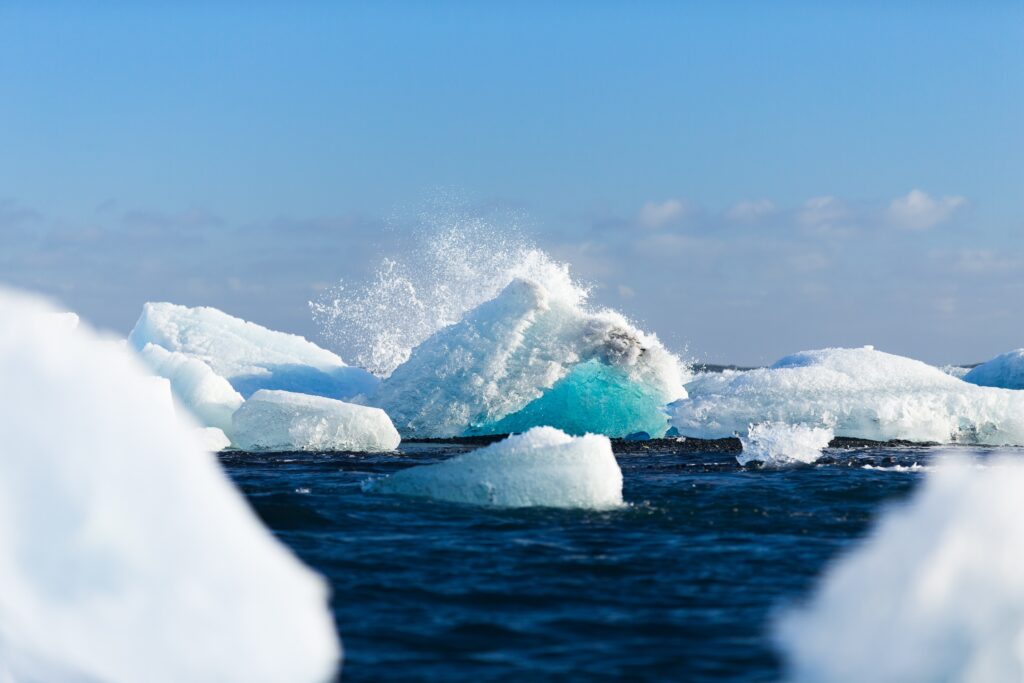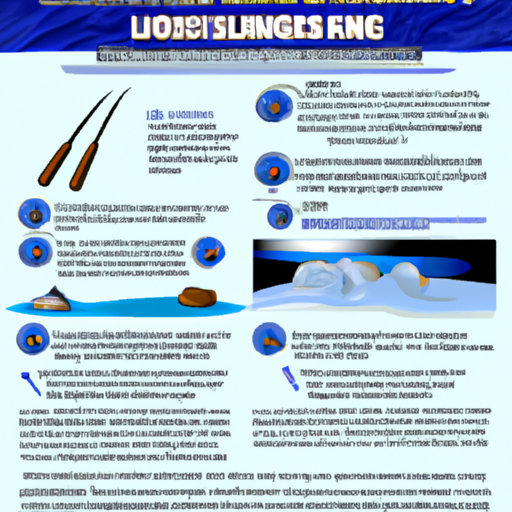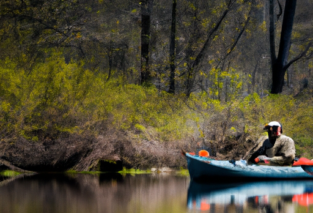Ice fishing is a popular winter activity that offers a unique experience for fishing enthusiasts. However, one common question that arises is whether it is possible to go ice fishing without an auger. In this article, we will explore essential tips and techniques that can help you enjoy the sport even if you don’t have access to an auger. From alternative methods to proper equipment choices, we’ve got you covered to make your ice fishing adventure a success. So, let’s get ready to hit the frozen waters and reel in some fish without the need for an auger!

Preparation
Ice fishing is a popular winter activity that requires careful preparation to ensure a successful and enjoyable experience. Before heading out onto the ice, there are several important steps to take.
Checking the Ice Thickness
The first and most crucial step in preparing for ice fishing is checking the ice thickness. Safety should always be your top priority, and venturing onto thin or unstable ice can be extremely dangerous. Consult with local authorities or experienced ice anglers to determine the minimum recommended ice thickness for fishing. Ice thickness requirements may vary depending on factors such as temperature, location, and recent weather conditions. It is essential to verify that the ice has a thickness of at least four inches before proceeding with your fishing plans.
Researching Fishing Spots
Finding the right fishing spot can greatly increase your chances of a successful outing. Researching potential ice fishing locations in advance can save you time and frustration on the day of your trip. Look for areas with a reputation for good ice fishing and consider factors such as accessibility, fish species availability, and ice conditions. Online forums, fishing guidebooks, and local fishing clubs can provide valuable insights and recommendations for finding the best fishing spots in your area.
Gathering Essential Equipment
To make the most of your ice fishing experience, it is important to gather all the necessary equipment before heading out onto the ice. Some essential items include a fishing rod and reel, fishing line, various weights and hooks, bait or lures, a fishing tackle box, ice skimmer or scoop to clear ice shavings, and a bucket or bag to keep your catch. Additionally, don’t forget to pack warm clothing, extra layers, and appropriate footwear to stay comfortable on the ice. It is always better to be over-prepared than under-prepared when it comes to ice fishing.
Organizing Your Gear
Keeping your ice fishing gear organized and easily accessible is key to a hassle-free experience. Before heading out onto the ice, take the time to organize your equipment. Sort your tackle box, ensuring you have a variety of hooks, sinkers, and lures readily available. Check that your fishing rod and reel are in good working condition and properly spooled with fishing line. Arrange your clothing and gear in a way that allows for easy access and minimizes the risk of tangling or losing items while on the ice. Being well-organized will save you time and frustration when you’re out trying to catch fish.
Alternative Ice Drilling Methods
Traditionally, ice fishing holes are drilled using an auger, but if you don’t have access to one, there are alternative tools and methods you can use to create fishing holes in the ice.
Hand Augers
Hand augers are manual drilling tools specifically designed for ice fishing. They typically consist of a long handle with a sharp, rotating blade at the bottom. Hand augers are lightweight, portable, and easy to use, making them a popular choice among ice anglers. To drill a hole with a hand auger, simply position the blade on the ice, apply downward pressure, and rotate the handle in a clockwise motion. Hand augers are ideal for drilling smaller diameter holes and are suitable for anglers who prefer a more traditional approach or want to avoid the noise and maintenance associated with power tools.
Chisel or Ice Spud
A chisel or ice spud is a long, heavy rod with a flat, chisel-like blade at the end. This tool is commonly used for breaking up large sections of ice, but it can also be used to create fishing holes. To drill a hole with a chisel or ice spud, position the blade on the ice and strike it forcefully with a hammer or mallet. Repeat this process until you have created a hole of the desired size. Using a chisel or ice spud requires significant physical effort and may take longer than other methods, but it is a viable option if you don’t have access to other tools.
Cordless Drill with an Auger Bit
If you already own a cordless drill, you can easily turn it into an ice fishing tool by attaching an auger bit. Auger bits are specifically designed to drill through ice and are available in various sizes to accommodate different fishing preferences. To use a cordless drill with an auger bit, simply secure the bit into the drill chuck, position the blade on the ice, grip the drill firmly, and apply steady pressure as you drill downward. Using a cordless drill with an auger bit offers the advantages of speed and ease of use, making it a popular choice among ice anglers who want a power tool option without the need for a dedicated auger.
Ice Saw
An ice saw is a specialized tool designed specifically for cutting through ice. It consists of a long, serrated blade with handles at each end for ease of use. Ice saws allow for precise cutting and are ideal for creating larger fishing holes or custom-shaped holes. To use an ice saw, place the blade on the ice, apply downward pressure, and use a sawing motion to cut through the ice. Ice saws require manual effort and may take longer to create a hole compared to other methods, but they offer versatility and precision.

Choosing the Right Tools
When it comes to choosing the right tools for ice fishing, several factors should be considered to ensure a successful and enjoyable experience.
Hand Auger Considerations
When selecting a hand auger, consider the blade size and design. Blades with a larger diameter create wider holes but require more effort to drill, while smaller diameter blades are easier to handle but create narrower holes. Blade design can also affect drilling efficiency. Consider blades with sharp, durable edges that can easily cut through ice. Additionally, pay attention to the overall weight and length of the hand auger. Lighter and shorter hand augers are generally more portable and easier to maneuver.
Selecting a Suitable Chisel or Ice Spud
If you opt for a chisel or ice spud for drilling, choose one that is made of durable materials like hardened steel or heavy-duty aluminum. Ensure that the blade is securely attached to the handle and doesn’t show signs of cracking or damage. Consider the length and weight of the chisel or ice spud, as heavier tools may require more effort to use but offer greater impact strength.
Evaluating Cordless Drills and Auger Bits
For those considering a cordless drill option, choose a drill with sufficient power, torque, and battery life. Look for a drill with a comfortable grip and an adjustable clutch for better control. When selecting an auger bit, consider the desired hole size and the availability of different blade styles. Stainless steel or carbon steel auger bits are commonly used for ice fishing due to their durability and ability to withstand the challenges of drilling through ice.
Understanding Ice Saw Features
If you decide to use an ice saw, choose one with a blade length suitable for the hole size you intend to create. Consider the teeth configuration of the saw, as it can affect cutting efficiency. Saws with more aggressive teeth may cut through ice faster but may leave a rougher surface. Look for ice saws with high-quality blades that are replaceable or can be sharpened for long-lasting use.
Techniques for Manual Ice Drilling
Using manual drilling methods for ice fishing requires proper technique to maximize efficiency and minimize physical exertion.
Using a Hand Auger Effectively
When using a hand auger, start by positioning the blade on the ice and ensuring it is flat and level. Apply downward pressure to engage the blade with the ice, and then begin rotating the handle in a clockwise motion. Maintain a steady and consistent pace while drilling. Monitor the progress of the auger and regularly clear away any ice shavings accumulating around the hole to prevent the blade from becoming jammed. Use your body weight to assist with drilling, as proper body mechanics can minimize fatigue and strain on your arms and back.
Maximizing Efficiency with a Chisel or Ice Spud
Using a chisel or ice spud effectively requires a combination of strength and technique. Position the chisel or ice spud on the ice surface, ensuring it is perpendicular to the ice and securely positioned. Deliver sharp, forceful blows to the handle using a hammer or mallet. Work your way around the desired hole area, breaking up the ice into smaller pieces. Remove the broken ice pieces regularly to provide access to fresh ice for easier drilling. Use the weight of the tool and the force of the strike to your advantage, as proper technique can help you break through the ice more efficiently.
Proper Usage of Cordless Drill and Auger Bit
When using a cordless drill with an auger bit, it is important to maintain a firm grip on the drill and maintain a steady downward force. Position the auger bit on the ice and ensure it is aligned and level. Start the drill at a slower speed to prevent the bit from skipping or jumping on the ice surface. As the drill gains momentum, gradually increase the speed while maintaining control. Apply consistent downward pressure as you drill to keep the bit engaged with the ice. Be cautious not to force the drill or push too hard, as this can strain the motor or cause the bit to bind. Monitor the drilling progress and periodically clear away ice shavings to ensure smooth drilling.
Sawing Through Ice with an Ice Saw
When using an ice saw, position the saw blade on the ice and apply downward pressure. Engage the serrated edge of the blade into the ice and use a continuous sawing motion to cut through the ice. Maintain a steady pace and apply pressure evenly to ensure a smooth and controlled cut. Avoid using excessive force, as this can cause the saw to bind or twist. Clear away ice shavings regularly to prevent them from interfering with the cutting process and to maintain a clean work area. Using gentle, fluid motions will allow you to make precise cuts and create the desired hole shape.

Maintaining Ice Holes
Creating and maintaining ice holes throughout your ice fishing expedition is essential for success.
Clearing Ice Shavings and Slush
After drilling a fishing hole, it is crucial to clear away any ice shavings and slush. This prevents them from obstructing your fishing line, interfering with fish detection, or freezing over and creating an uneven surface. Use a skimmer or scoop to remove the ice shavings and slush from the hole. By keeping the hole clear, you ensure better visibility and improve your chances of attracting fish to your bait or lures.
Preventing Ice Refreezing
In cold temperatures, ice holes can quickly refreeze if left unattended. To prevent ice refreezing, periodically pour hot water into the hole or use a hand auger to agitate the existing water. This helps to break up any thin ice and maintain an open hole. Additionally, removing ice shavings and slush promptly after drilling reduces the chances of refreezing. By actively maintaining your ice holes, you ensure that your fishing area remains accessible and inviting to fish.
Using a Skimmer or Scoop
A skimmer or scoop is an essential tool for maintaining ice holes during ice fishing. It is used to remove ice shavings, slush, and any debris that may accumulate in the fishing hole. To use a skimmer or scoop, simply place it into the hole and scoop out the unwanted material. Choose a skimmer or scoop with a long handle to provide better reach, especially if you are fishing in deep ice. By regularly clearing your fishing hole, you create an optimal environment for attracting fish and increase your chances of a successful catch.
Tools for Widening and Deepening Holes
Sometimes, you may want to widen or deepen an existing ice hole to accommodate larger fish or to experiment with different fishing techniques. Various tools are available to make this process easier. Hand augers can be used to widen the hole incrementally by drilling additional circles around the original hole. Chisels or ice spuds can also be used to break away excess ice and widen the hole. For deepening a hole, you can use an ice saw or cordless drill with an auger bit to cut a larger diameter hole deeper into the ice. These tools allow for customization based on your fishing needs and preferences.
Safety Considerations
Ice fishing can be a safe and enjoyable activity, but it is crucial to prioritize safety at all times. Understanding ice conditions and hazards, wearing appropriate clothing and safety gear, informing someone about your fishing plans, and using ice picks and a safety rope are essential safety considerations.
Understanding Ice Conditions and Hazards
Before venturing onto the ice, it is crucial to understand the ice conditions and potential hazards. Ice thickness, cracks, open water areas, and changing temperatures can significantly affect ice stability. Be aware of recent weather conditions and consult with local authorities or experienced ice anglers for up-to-date information regarding ice safety. Avoid areas with thin or cracked ice, and stay away from open water or areas with visible signs of instability. Always err on the side of caution and prioritize your safety above all else.
Wearing Appropriate Clothing and Safety Gear
Wearing appropriate clothing and safety gear is vital for ice fishing. Dress in layers to regulate your body temperature and protect yourself from the cold. Start with a base layer of moisture-wicking fabric, followed by an insulating layer to keep you warm. Wear a waterproof and windproof outer layer to protect against moisture and wind chill. Insulated gloves or mittens, thermal socks, and sturdy waterproof boots are also essential for protecting your extremities from the cold. Don’t forget to wear a warm hat or headband to prevent heat loss through your head. Additionally, wearing a life jacket or flotation suit is highly recommended, especially when venturing onto larger bodies of water or areas with unpredictable ice conditions.
Informing Someone about Your Fishing Plans
Before heading out onto the ice, always inform someone about your fishing plans. Share your intended fishing location, estimated duration of your trip, and expected time of return with a trusted friend or family member. This way, if an emergency arises or you fail to return on time, someone will know to initiate a search or provide assistance. Having someone aware of your plans can significantly improve response time in case of an unforeseen event or accident.
Using Ice Picks and a Safety Rope
To enhance personal safety while ice fishing, it is recommended to carry ice picks and a safety rope. Ice picks are handheld devices with sharpened points designed to help you pull yourself out of the water should you fall through the ice. Wear the ice picks around your neck or attach them to your jacket for quick access. In the event that you fall through the ice, use the picks to grip the ice from the water and pull yourself onto the surface. A safety rope can also be a valuable tool to have when ice fishing. Tie one end of the rope around your waist or securely attach it to your clothing, and let the other end extend onto the ice. If you fall through the ice, the safety rope can provide assistance to others in helping you get out of the water safely.

Caring for Your Equipment
Properly caring for your ice fishing equipment is essential to ensure its longevity and optimal performance.
Cleaning and Drying Tools after Use
After each ice fishing trip, take the time to clean and dry your tools properly. Remove any excess ice shavings, slush, or debris from your fishing gear using a brush or cloth. Rinse off any saltwater or dirt from your equipment, paying particular attention to metallic parts to prevent corrosion. Once clean, allow your tools to air dry thoroughly before storing them. This helps to prevent the growth of mold or mildew and ensures that your equipment remains in good condition for future use.
Applying Lubrication to Hand Augers
If you use a hand auger, it is important to periodically apply lubrication for smoother operation. Lubricate the rotating blade and any moving parts using a suitable oil or lubricant designed for cold weather conditions. This helps to reduce friction and prevents the blade from sticking, ensuring efficient drilling and prolonging the life of your hand auger. Follow the manufacturer’s instructions for proper lubrication and storage guidelines to maintain your hand auger’s performance.
Sharpening Blades and Maintaining Sharpness
Regularly inspect and sharpen the blades of your ice drilling tools to maintain their sharpness. Dull blades can slow down drilling progress and increase the effort required to create holes. Use a sharpening stone, file, or sharpening kit to remove any nicks or dull areas on the blade. Follow the manufacturer’s instructions for proper sharpening techniques and always exercise caution when handling sharp objects. Maintaining sharp blades contributes to efficient drilling and extends the lifespan of your equipment.
Storing Equipment Properly
When the ice fishing season is over, store your equipment properly to protect it from damage and ensure its longevity. Clean and dry all your tools thoroughly before storing them. Store your equipment in a dry, cool, and secure location, such as a garage or storage shed, to prevent exposure to moisture, extreme temperatures, and pests. If possible, hang your fishing rods vertically or store them in rod cases to protect them from bending or warping. Keep your tackle box organized and consider using tackle trays or dividers to separate different types of tackle. Storing your equipment properly keeps it in good condition and ready for future ice fishing adventures.
Ice Fishing Techniques
Ice fishing techniques vary depending on the location, fish species, and personal preferences of the angler. Understanding different techniques can greatly improve your chances of success on the ice.
Choosing the Right Bait and Lures
Selecting the right bait and lures is essential for attracting fish to your fishing hole. Consider the fish species you are targeting and familiarize yourself with their feeding habits and preferences. Live bait such as minnows, worms, or insect larvae can be highly effective in enticing fish to bite. Artificial lures, such as jigs, spoons, or soft plastics, can also be used to mimic the behavior and appearance of natural prey. Experiment with different colors, sizes, and retrieval techniques until you find what works best for the fish species you are targeting.
Using Tip-Ups without an Auger
Tip-ups are devices designed to suspend your fishing line in the water while you wait for a fish to bite. They consist of a spool or reel connected to a flag mechanism that signals when a fish has taken the bait. If you don’t have access to an auger, you can still use tip-ups by searching for existing fishing holes or widening holes created by other anglers. Be respectful and avoid drilling too close to existing holes to maintain the etiquette of the ice fishing community. When using tip-ups, monitor them regularly and be prepared to respond quickly when a fish takes the bait.
Setting Up a Portable Shelter
A portable shelter, such as an ice fishing tent or shanty, provides protection from the elements and enhances comfort during your ice fishing trips. Setting up a portable shelter involves selecting a suitable location on the ice and assembling the shelter according to the manufacturer’s instructions. Choose a shelter with sufficient space for you, your gear, and any fellow anglers joining you. Clear the snow from the area where the shelter will be set up to create a level surface. Anchoring the shelter to the ice using stakes or anchors helps to prevent it from shifting or blowing away in strong winds. A well-organized and insulated portable shelter greatly enhances your ice fishing experience, making it more enjoyable even in extreme weather conditions.
Understanding Fish Behavior in Winter
Fish behavior can vary significantly during the winter months, and understanding their patterns and tendencies can greatly improve your chances of success. As water temperatures drop, fish tend to become less active and may move to deeper parts of the body of water. They may also seek areas with vegetation or structure that offer cover and a food source. Research the specific fish species you are targeting to discover their preferred water temperature range, feeding habits, and preferred habitat. Adjust your fishing techniques accordingly, such as fishing at different depths, using different types of bait or lures, and exploring areas with suitable structure or vegetation. Being knowledgeable about fish behavior in winter allows you to adapt your strategies and increase your chances of a successful catch.

Maximizing Success
To maximize success on the ice, it is important to maintain a positive mindset, adjust techniques according to conditions, experiment with depth and location, and learn from experienced ice anglers.
Being Patient and Observant
Ice fishing requires patience and attentiveness. Fish may take longer to bite in cold temperatures, so it is important to remain patient and persistent. Monitor your fishing lines, tip-ups, or underwater cameras closely for any signs of fish activity. Observe the behavior of other anglers on the ice and notice any patterns or trends that may indicate fish movement or feeding. By staying observant and attentive, you increase your chances of detecting subtle fish cues and adjusting your strategies accordingly.
Adjusting Techniques According to Conditions
Ice fishing conditions can change rapidly, and it is essential to adapt your techniques accordingly. Pay attention to factors such as weather conditions, water clarity, and fish activity. On bright and sunny days, fish may be more active near the surface or in shallower water. Conversely, on cloudy or windy days, they may move to deeper or sheltered areas. Adjust your fishing techniques, such as bait selection, depth, and presentation, to match the prevailing conditions. Be open to experimenting and trying different approaches until you find what works best under specific circumstances.
Experimenting with Depth and Location
Fish behavior and preferences can vary depending on the depth and location of the water. To increase your chances of success, experiment with different depths and fishing locations. Start by trying different depths within a specific area. If you don’t get any bites, gradually move to different parts of the body of water, focusing on areas with potential fish habitat, such as drop-offs, weed beds, or structure. By exploring different depths and locations, you can identify the areas where fish are more likely to be present and concentrate your efforts accordingly.
Learning from Experienced Ice Anglers
Learning from experienced ice anglers can provide valuable insights and tips to enhance your ice fishing skills. Engage in conversations with seasoned ice anglers, join local fishing clubs, or participate in ice fishing events to network and learn from others. Experienced anglers can share their knowledge of fishing spots, bait preferences, ice conditions, and effective techniques. They may also offer advice on specific fish species behavior, ice fishing safety, and the best times to fish. Listening and learning from those who have honed their skills over time can significantly improve your ice fishing success and overall enjoyment.
Essential Tips for Ice Fishing without an Auger
While having an auger can greatly facilitate ice fishing, it is still possible to enjoy this activity without one. Here are some essential tips for ice fishing without an auger.
Plan Ahead and Be Prepared
When ice fishing without an auger, it is even more important to plan ahead and be prepared. Research fishing spots with existing holes or areas where drilling may have already occurred. Confirm with local ice fishing communities or forums if any specific locations are known for having pre-drilled holes. Always have a backup plan in case you are unable to find suitable existing holes. If you decide to drill your own holes using alternative methods, ensure you have the necessary tools and equipment readily available.
Practice Using Alternative Drilling Tools
If you are unfamiliar with alternative drilling tools, spend some time practicing their use before heading out onto the ice. Become comfortable with the technique and effort required for each tool. This will help ensure a smoother and faster drilling process when you are on the ice. Practicing also allows you to become familiar with the limitations and capabilities of different tools, enabling you to choose the most suitable equipment for your ice fishing needs.
Focus on Safety and Proper Equipment Maintenance
When ice fishing without an auger, safety becomes even more critical. Pay extra attention to ice conditions, hazards, and personal safety. Ensure that your alternative drilling tools are in good condition and properly maintained. Regularly inspect the tools for any signs of wear or damage, such as dull blades, loose handles, or rust. Promptly address any maintenance issues to ensure safe and effective tool operation. Invest in quality tools that are specifically designed for ice fishing to minimize the risk of accidents or injuries.
Combine Effective Drilling Techniques with Fishing Strategies
Successfully ice fishing without an auger requires combining effective drilling techniques with fishing strategies. Be flexible and adaptable in your approach, adjusting fishing techniques based on the conditions and available holes. Choose bait and lures that are suitable for the target fish species and the fishing location. Experiment with different fishing depths and locations, as fish behavior can vary depending on the existing holes. By combining efficient drilling techniques with strategic fishing approaches, you can enjoy a rewarding ice fishing experience even without an auger.
In conclusion, ice fishing without an auger is possible with the right preparation, alternative drilling tools, proper techniques, and a focus on safety. By checking the ice thickness, researching fishing spots, gathering essential equipment, and organizing your gear, you set the foundation for a successful ice fishing trip. Understanding different alternative drilling methods and choosing the right tools for your needs allow you to create the necessary fishing holes on the ice. Practicing effective drilling techniques, maintaining ice holes, and prioritizing safety precautions ensure a safe and enjoyable experience. Finally, by caring for your equipment, applying appropriate fishing techniques, and maximizing your chances of success, you can make the most of your ice fishing adventure. Whether you have an auger or not, ice fishing offers a unique and rewarding way to enjoy the winter season while pursuing your passion for angling.





